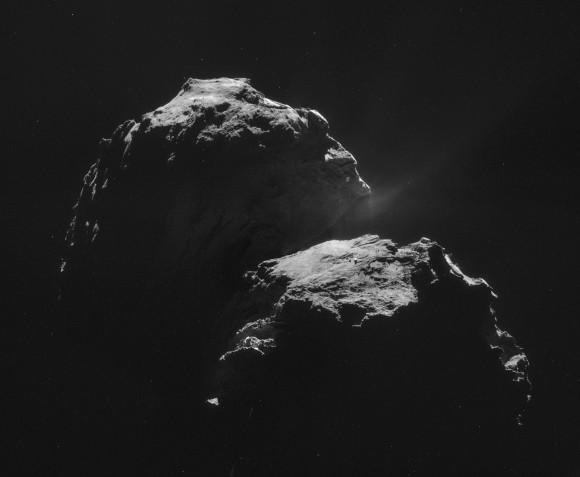
In one of most fascinating announcements yet from 2014’s most exciting space mission – ESA’s Rosetta mission to Comet 67P/Churyumov-Gerasimenko – researchers this week (December 10) said that water vapor from Rosetta’s comet is very different from earthly water. Very different. There appears to be three times the concentration of deuterium-enriched water (heavy water) in the water vapor from Rosetta’s comet as in the water on Earth. This discovery suggests that water in Earth’s oceans did not come from comets. Did it come from asteroids instead?
Why can’t Earth simply have been born with its water? Models of the early solar system suggest that Earth was extremely hot soon after its formation, 4.6 billion years ago. On a molten Earth, the water would have boiled away.
For this reason, over the past several decades, the idea has taken root that Earth’s water came from outer space, specifically from comets, during an era of heavy cometary bombardment early in our planet’s history.
Scientists look to a well-known ratio between ordinary water and heavy water in Earth’s oceans for clues to the origin of Earth’s water. Out of every 10,000 water molecules on Earth, three are heavy water molecules. Heavy water is much like ordinary water (two atoms of hydrogen and one of oxygen), except that, in heavy water, one hydrogen atom is replaced by deuterium (hydrogen, with an extra neutron in its nucleus).
Comets contain primitive material leftover from the days in which our solar system formed. So analyzing the water in comets – and comparing it to Earth’s water – should tell us whether Earth’s water originated in comets. Of course, it’s not as easy as it sounds. Theoretical simulations showing that the deuterium/hydrogen ratio should change with distance from the sun and with time in the first few million years. Comets can be found in various parts of the solar system, and they don’t stay put in their orbits. Long-period comets from the Oort cloud on the fringes of our solar system, for example, are thought to have formed originally in Uranus–Neptune region.
Still, measuring the ratio in comets is a critical key to proving or disproving the theory of cometary origins for Earth’s water.
So far, astronomers have measured the deuterium/hydrogen ratio 11 comets. Only one, Comet 103P/Hartley 2, has a deuterium/hydrogen ratio matching the composition of Earth’s water. The other comets measured show a wide range of values.
The deuterium/hydrogen ratio for Rosetta’s comet is more than three times greater than for Earth’s oceans and for Comet Hartley 2. It’s even higher than that measured for any Oort cloud comet. That measurement came from an instrument aboard Rosetta called ROSINA (Rosetta Orbiter Spectrometer for Ion and Neutral Analysis) in the month following the arrival of the spacecraft on August 6, 2014. ESA announced the finding this week because the first published paper from the Rosetta mission, containing this finding, appeared December 10 in the journal Science.
Meanwhile, meteorites originating in our solar system’s asteroid belt – between Mars and Jupiter – match the composition of Earth’s water. Asteroids have a lower water content than comets, but impacts by a large number of asteroids might have given Earth its oceans.
Kathrin Altwegg is principal investigator for the ROSINA instrument and lead author of the paper reporting these results in this week in Science. She said:
Our finding also rules out the idea that Jupiter-family comets contain solely Earth ocean-like water, and adds weight to models that place more emphasis on asteroids as the main delivery mechanism for Earth’s oceans.

Bottom line: There’s three times the concentration of deuterium-enriched water (heavy water) in the vapor from Rosetta’s comet as in the water on Earth.











